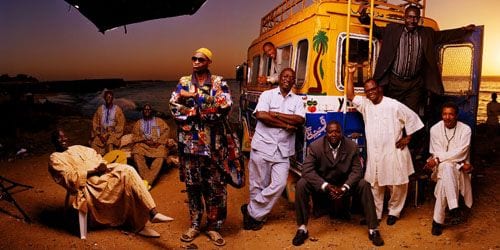
The speed with which we can exchange information has certainly changed our world, but when it comes to art — and, in this case, music — speed hasn’t yielded many lasting cultural combinations. Instead, the way with which culture is shared mirrors the way in which it takes effect, which is to say that musical influences seem to have become increasingly of the moment and fleeting. Look back at how quickly bands cited Animal Collective’s 2009 album Merriweather Post Pavilion as an influence. It felt then, and still does now, like a reactionary and shallow response to a popular new sound.
The Syllart African Pearls series reminds us of a time when culture traveled more slowly, but the roots it took ran far deeper when it found new soil. Afro Latin Via Dakar and Afro Latin Via Kinshasa look at the influence of Cuban music on coastal African towns and, in doing, so reveal a vibrant and crucial meshing of two lively musical traditions. It all started with simple gestures, with sailors returning to port with 78s and sharing the music. Local musicians then learned the songs by ear and began working them into their own traditions.
Both compilations show clearly the two sides of the Afro Latin sound right off the bat. These songs have the percussive weight of Afro-beat, but instead of the sharp edge that sound hinges on, the more swaying tempo of Latin music steps in. The use of horns on these records — particularly trumpet and saxophone — makes for fuller sounds and borrows from both African jazz and Cuban traditions. This music was a heady mix of both local and outside influences. On Via Dakar, you can see how Dexter Johnson, saxophonist for the influential Dakar’s Star Band, brought the sharp riffs of Nigerian music into the mix on jazzy standout “Si Tu No Vienes”. Orchestre Baobab, another major Senegalese band, incorporated a more pop-oriented vibe, and brought in sounds from Mali and other places to produce more direct, infectious songs like “Jarraaf” and compilation closer “Pape Ndiaye”.
On Via Kinshasa, we hear influence of R&B and local dance traditions — a myriad different dances were often lumped under the “rumba” umbrella — and the sound is a bit more laid back than Via Dakar. This is hip-swaying music, for sure, sounds that leave room for you to move in. Franco-OK Jazz’s sound, on great songs like “Del Prison” and “Cha Cha Modiero”, rests on gliding riffs and sweetly melodic vocals. The beats to these songs are simpler but effective, leaving space for the horns to work while still getting feet tapping right away. Tabuley Rochereau, another major artist represented here, was once so influenced by a visit to Kinshasa by James Brown that he started a soul band called the Rocherettes. Here, his work with African Fiesta reflects that same love of soul music. Check out the funky stomp of “Metiroso” or the sweeter crooning of “African Club” and you can feel Brown’s influence deeply, even as the horns evoke more Latin shuffle than funk strut.
The music here is strong throughout, and the sheer amount of it — each compilation is two discs and two-and-a-half hours or so of music — is generous and stunning. Unlike many compilations of their kind, though, Via Dakar and Via Kinshasa delve deeply into a few key artists instead of giving us a wider cross-section of the musicians from that time and place. There is a benefit to this, since we get to know more about Franco-OK Jazz or Orchestre Baobab than one or two songs could tell us, and it is interesting to see how these bands change and stretch out over a handful of songs.
There’s a drawback to this, too, though. When we get, say, nine Franco-OK Jazz songs on Via Kinshasa — not to mention nine from Rochereau, eight from Docteur Nico, five from Grand Kalle, and so on — the context for other artists gets lost a little bit. It’s easy to see why they focus where they do, since the performers are great, but one-track artists like Africa Vox or Negro Succes get lost in the shuffle. They deliver with solid tracks, but play second fiddle to the bigger bands. The same is true of Via Dakar, which leans heavily on Dakar’s Star Band and Orchestre Baobab. Again, to get a glimpse into the evolution of these bands is compelling and often exciting, but the compilations’ stories — about the fusion of music in these regions, about its larger effect — might get obscured in focusing only on the most prominent players. Via Dakar and Via Kinshasa are expansive and entertaining compilations, but in the end they may be more compelling documents of meshing cultures than as complete representatives for Afro Latin music in those coastal towns.

![Call for Papers: All Things Reconsidered [MUSIC] May-August 2024](https://www.popmatters.com/wp-content/uploads/2024/04/all-things-reconsidered-call-music-may-2024-720x380.jpg)



